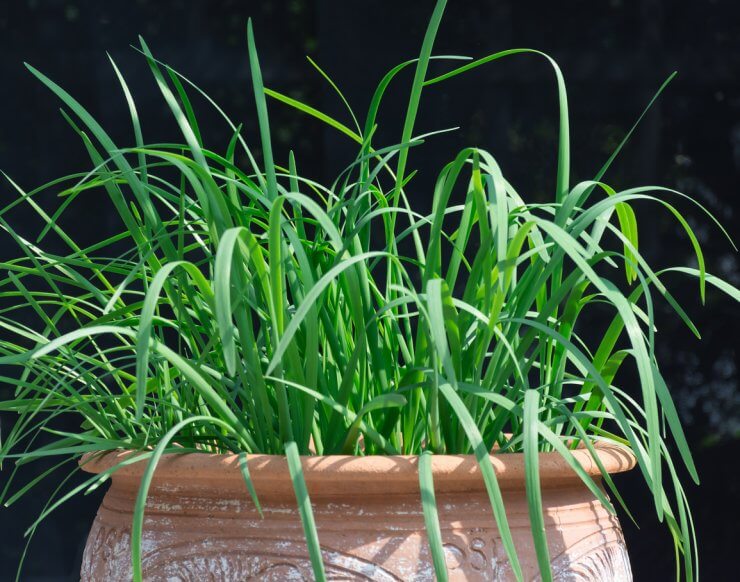
Healthy chives growing in a pot
Like all food crops, chives are susceptible to various fungal diseases. Your best weapons against these are best planting practices, which help prevent disease in the first place.
This is especially important, as there are no fungicides approved for home use for many diseases.
These best practices are aimed at producing strong, healthy plants that can withstand disease, and at avoiding situations that contribute to the development of disease. They involve keeping plants clean, dry, and undamaged.
Watering: Water your chives deeply about once a week (check the soil for dryness). Do not over-water; chives hate having wet feet! Soggy soil invites disease.
Mulch: Mulch can help with water retention—but be vigilant and check for insect or fungal activity.
Other best practices include:
- Buy healthy, disease-free plants from reputable sources
- Plant your plant in full sun
- Plant in sites with good drainage; if planting in open ground, choose a higher spot for better drainage
- Harvest frequently and remove infected leaves
Common Chive diseases
Here are some of the usual culprits that might infest your chive plants. Remember, it’s important to remove flowers and leaves to prevent the spread of disease once it’s found its way onto your plant.
Damping-off
Cause: Fungi
Symptoms:
- water-soaked, decomposing seeds
- infected roots are gray and water-soaked
- seedlings that grow but then collapse and die
- older plants that get infected are severely stunted
How it Spreads:
- spores thrive in moist soil and cool temperatures
Treatment:
- liquid copper fungicide, if infection is severe
- remove and discard infected parts
Prevention:
- minimize soil moisture
- break up compacted soil
- plant in well-draining areas
- treat seeds with fungicides before planting
Downy Mildew
Cause: Fungi
Symptoms:
- pale spots or long pale patches on leaves
- gray-purple fuzzy growth on leaf surface
- leaves turn pale, then yellow
- leaf tips collapse
How it Spreads:
- splashing water (rain, irrigation) disturbs spores
- cool temperatures favor growth
Treatment:
- destroy infected plants
- apply foliar fungicides
Prevention:
- purchase disease-free plants
- rotate crops with non-allium species for three to four years
- plant in well-draining areas
- homemade fungicides
- choose planting sites with good air movement and no shade
Pink Root
Cause: Fungi
Symptoms:
- roots appear pink, then darken to purple
- roots become transparent and water-soaked
- stunted plants with shriveled bulbs
- dying seedlings
How it Spreads:
- fungus colonizes in root tips
- fungus can survive in soil to a depth of almost 18 inches
Treatment:
- remove and destroy all infected plant parts
- solarize/fumigate soil to reduce the presence of fungus
Prevention:
- plant disease-resistant varieties
- do not plant in areas where onions have recently grown
- provide proper water and fertilizer
Which diseases have you had to treat on your chives? Please tell us how you prevent and handle diseases. If you spot other symptoms on your chives that are not mentioned here, contact your local extension center or garden center for a consult—and please let us know what you discover.


 Previous
Previous


Is there an article detailing how to grow chives indoors for the winter?